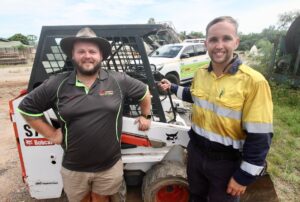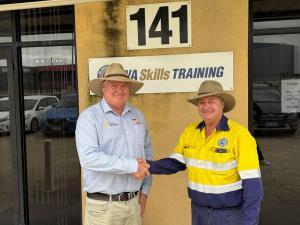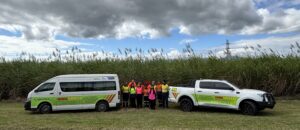Civil Safety Mackay has moved to a bigger training centre!...
Read MoreRisk Management Fundamentals for a Safe Work Environment

Each day on a job site is filled with challenges, but when it comes to safety, there’s one challenge that must be faced head-on – managing risks. This week, as part of National Safe Work Month, we’re focusing on the fundamentals of risk management. For those in the mining and construction industries, understanding how to identify hazards and control risks is not just a regulatory requirement, it’s a commitment to looking out for your mates and ensuring everyone returns home safely.
As we move into week three of National Safe Work Month, let’s dive into the fundamentals of risk management that can keep your workplace safe.

Identify Hazards and Evaluate Associated Risks
The first step in effective risk management is identifying hazards in your workplace. In the mining and construction industries, this can include everything from heavy machinery and unstable structures to hazardous materials and environmental risks. Regularly inspecting the worksite and engaging your team in discussions about potential hazards can help build a culture of safety.
How to Identify Hazards
- Site Walkthroughs: Regularly walk the site with your team to spot any hazards. Look for things that could cause injury – both obvious and hidden risks.
- Consult Your Crew: Encourage your team to speak up about any concerns. They are your eyes and ears on the ground and can provide insights into potential dangers.
- Check Equipment: Always inspect machinery and tools for wear and tear. Faulty equipment can create serious hazards that are easily preventable
Once hazards have been identified, the next crucial step is assessing the risks associated with each hazard. This involves both the likelihood of an incident occurring and the potential severity of the consequences.
Risk Assessment Steps
Identifying and assessing risks sets a solid foundation for effective risk management.
- Determine Likelihood: Assess how likely it is that each hazard will lead to an incident. Consider past incidents, environmental conditions, and operational factors.
- Evaluate Consequences: What could happen if an incident occurs? Evaluate the severity of potential injuries. Understanding the worst-case scenario helps you prioritise risk controls.

Control The Risks
Once you have identified and assessed the risks, the next step is to control them effectively. The Hierarchy of Controls is a widely accepted framework that can guide you in implementing the most effective measures to mitigate risks.

Effective Control Measures
- Elimination: The best way to control a risk is to eliminate the hazard altogether. For example, if a particular tool is causing frequent injuries, consider replacing it with a safer alternative.
- Substitution: If elimination isn’t possible, consider substituting the hazard with something less risky. For instance, using less toxic materials can reduce the risk of exposure.
- Engineering Controls: These are physical changes to the workplace that can minimise risk. Installing guards on machinery or improving ventilation systems are common engineering controls.
- Administrative Controls: These involve changes in procedures or policies to reduce risk. Implementing regular safety training or enforcing stricter work protocols can significantly lower injury rates.
- Personal Protective Equipment (PPE): While it should be the last line of defense, providing appropriate PPE is essential. Ensure that your workers have access to quality safety gear, and train them on how to use it correctly.

Monitor and Review Regularly
After implementing control measures, it’s crucial to monitor their effectiveness and make necessary adjustments. Risk management isn’t a one-and-done deal; it requires ongoing vigilance.
Key Steps in Monitoring and Reviewing
- Conduct Regular Inspections: Make site inspections a routine. Are the control measures working? Are there new hazards that need assessment?
- Gather Feedback: Encourage your crew to provide input on safety measures. Their experiences can highlight areas for improvement.
- Track Incidents: Document any incidents or near-misses. Analyze them to understand what went wrong and how similar situations can be prevented in the future.
- Review Training: Continually assess and update training programs. Keeping skills sharp ensures everyone knows how to handle risks effectively.
By creating a culture of safety where everyone feels responsible, you can make significant strides in risk management. Remember, the goal is not just compliance, but a genuine commitment to protecting lives.
At Civil Safety, we are committed to equipping you and your team with the knowledge and skills necessary to maintain a safe workplace. Explore our comprehensive range of courses to ensure you’re prepared to tackle workplace risks effectively.
About Civil Safety
Civil Safety is a leading Registered Training Organisation (RTO 32381) for the mining, civil and construction industries, with operations across Queensland and Western Australia.
We provide safety and operational training to thousands of people every year from a diverse range of backgrounds. Our highly experienced trainers bring real-world experience to the classroom – ensuring our students graduate ready for work with the skills, confidence and qualifications required for safe and compliant operation in dangerous environments.
With a vast range of courses, plus a variety of learning methods including face-to-face, blended and online – we can help you gain the skills you need to enter a new industry or upskill in your current career.
Find out more information on the range of health and safety courses we offer, or give us a call on 1300 CIVIL S.
Civil Safety Student Brett Snodgrass Wins Vocational Student of the Year
Celebrate Brett Snodgrass, our Civil Safety student who won Vocational...
Read MoreContinuing a Legacy in Mackay – Civil Safety Acquires Col Joy Training
Discover how Civil Safety's acquisition of Col Joy Training enhances...
Read MoreShaping Futures: Civil Safety Students Shine as Finalists in 2025 Queensland Training Awards
Meet our exceptional Civil Safety students, finalists in the 2025...
Read MoreCivil Safety Continues Western Australian Expansion with Acquisition of WA Skills Training
Civil Safety Continues Western Australian Expansion with Acquisition of WA...
Read MoreMental Health Matters: Supporting Wellbeing in High-Risk Industries
Mental Health Matters: Supporting Wellbeing in High-Risk Industries In the...
Read MoreTrinity Bay SHS Students Visit Local Cane Farms as Part of Rural Ops Training
Trinity Bay SHS Students Visit Local Cane Farms as Part...
Read MoreCivil Safety Backs Rockhampton Boxing and Sport Promotions Club in 5-Year Sponsorship to Empower Local Youth
Civil Safety Backs Rockhampton Boxing and Sport Promotions Club in...
Read More







